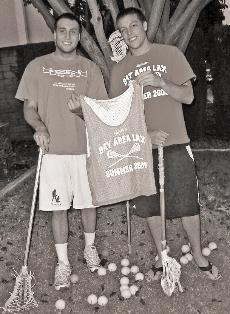Athletes start youth lacrosse clinics, lessons

 Feb. 3, 2009
Feb. 3, 2009 Lack of lacrosse in Bay Area kick starts Bronco business
Story is courtesy of The Santa Clara - By: Sol Tran - Issued 1/29/09
 Santa Clara alumnus Pete Carolan '08 and senior Kevin Carter love to play lacrosse. Now, using their business education and lacrosse experience, they have created a company to spread that love to youth all over the Bay Area. Santa Clara alumnus Pete Carolan '08 and senior Kevin Carter love to play lacrosse. Now, using their business education and lacrosse experience, they have created a company to spread that love to youth all over the Bay Area.
Bay Area Lax is one of the premier youth lacrosse clinics in the area. It provides a wide array of services that include summer lacrosse leagues, private conditioning lessons, private clinics and small group clinics.
Carolan is the founder and director and Carter is the planning and training coordinator of Bay Area Lax.
Carter, with his experience on a top-ten Division III lacrosse team at Stevens Institute of Technology, heads the clinics. He played for SIT during his sophomore year before transferring to Santa Clara. Bay Area Lax's clinics have generated $4,500 in revenue.
"It is great to be able to apply our business knowledge and build something that incorporates a real passion of mine," said Carter.
The idea for Bay Area Lax first sprouted up when Carolan, who was coaching the girls' varsity team at Gunn High School in Palo Alto, realized that there were no girls' summer lacrosse leagues in California like there are in his home state of New Jersey.
"I realized that there was no real infrastructure for women's training," said Carolan. "The boys had some, but there is still a very large and growing demand. We learned in our business classes that good businesses solved a problem and filled a demand," he said.
Last summer, Carolan and Carter opened up a summer league for girls with 92 participants made up of high school students from the Bay Area. This league brought in over $14,000 in revenue.
The two-month summer league featured 12-on-12 teams with Jenn Babaie and Kayla Ushman, two Santa Clara women's lacrosse players, acting as coaches.
Carolan and Carter also ran a clinic for boys, albeit much smaller. It consisted of two sessions with eight players each, thus enabling much more one-on-one instruction.
Link to Full Story
|




 Santa Clara alumnus Pete Carolan '08 and senior Kevin Carter love to play lacrosse. Now, using their business education and lacrosse experience, they have created a company to spread that love to youth all over the Bay Area.
Santa Clara alumnus Pete Carolan '08 and senior Kevin Carter love to play lacrosse. Now, using their business education and lacrosse experience, they have created a company to spread that love to youth all over the Bay Area.